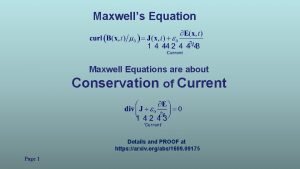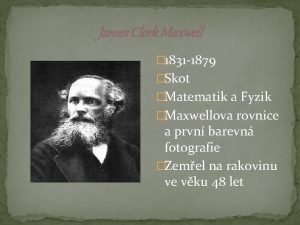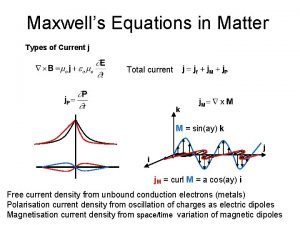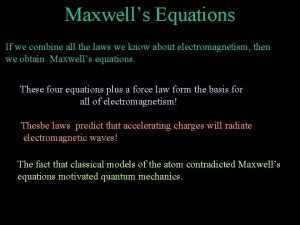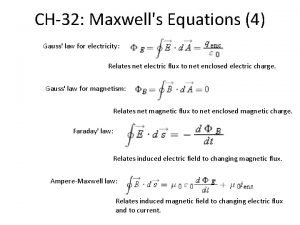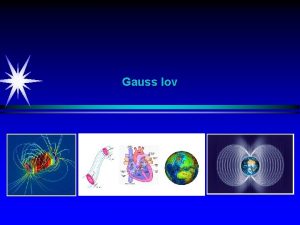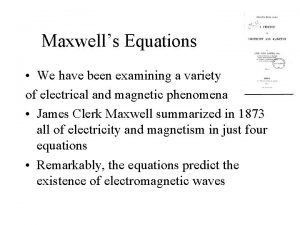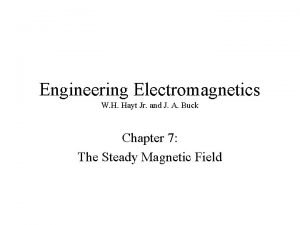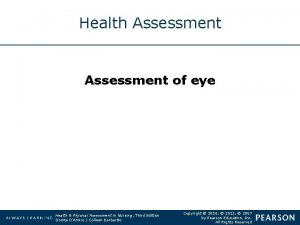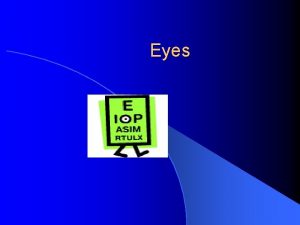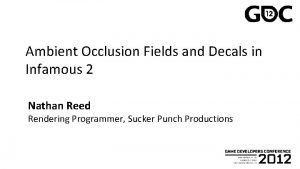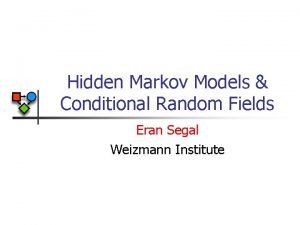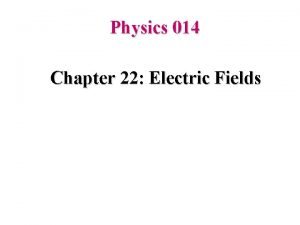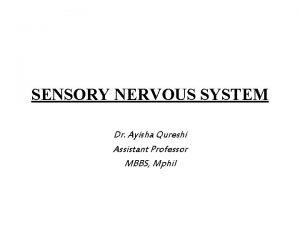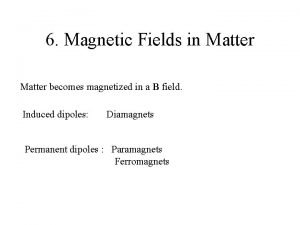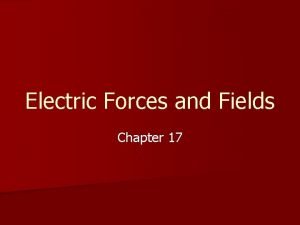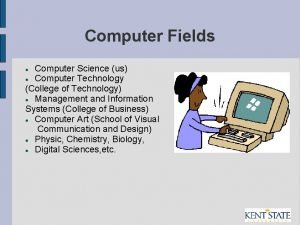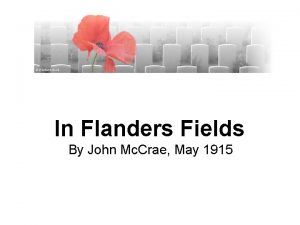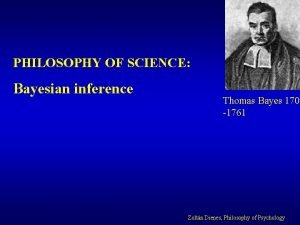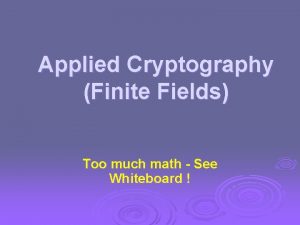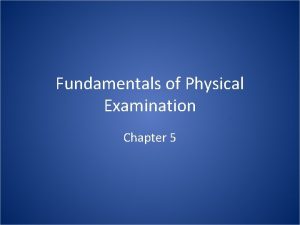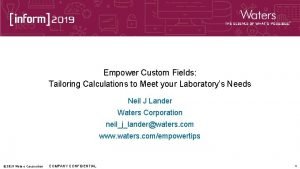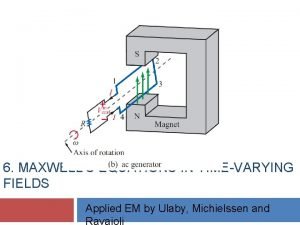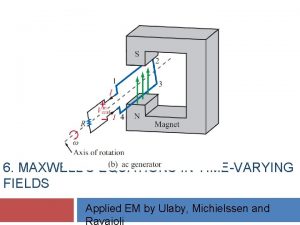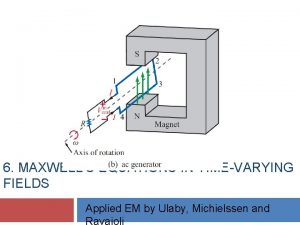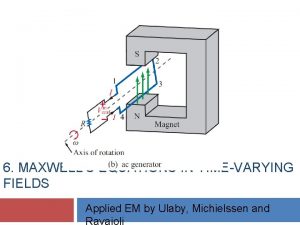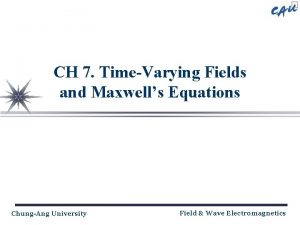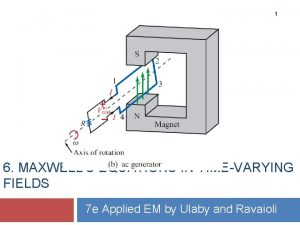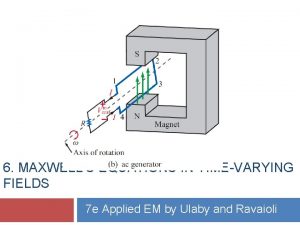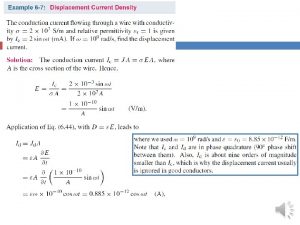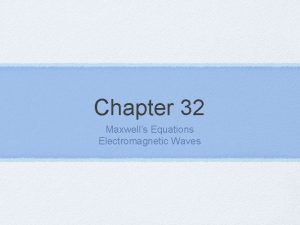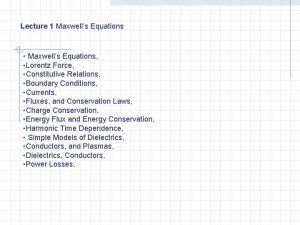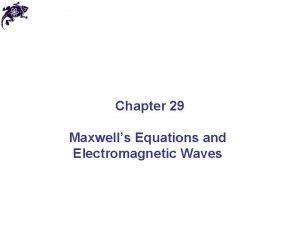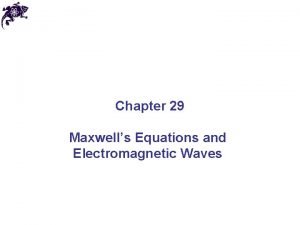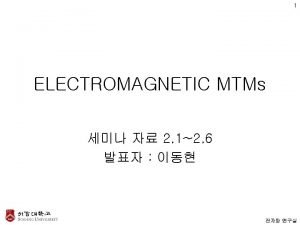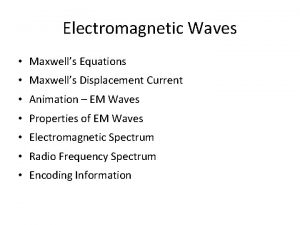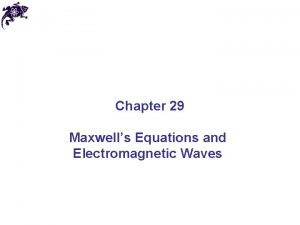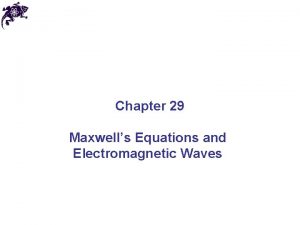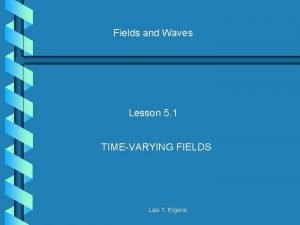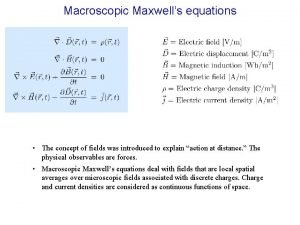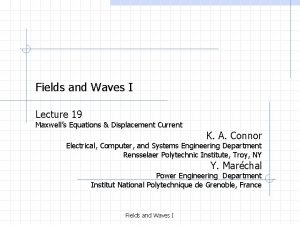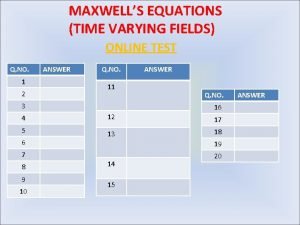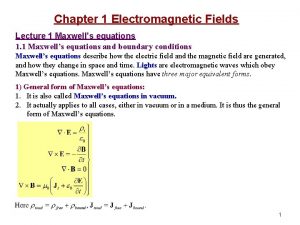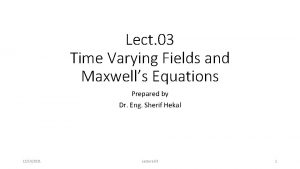6 MAXWELLS EQUATIONS IN TIMEVARYING FIELDS Applied EM








































- Slides: 40

6. MAXWELL’S EQUATIONS IN TIME-VARYING FIELDS Applied EM by Ulaby, Michielssen and

Chapter 6 Overview

Maxwell’s Equations In this chapter, we will examine Faraday’s and Ampère’s laws

Faraday’s Law Electromotive force (voltage) induced by time-varying magnetic flux:

Three types of EMF

Stationary Loop in Time-Varying B

cont.

Example 6 -1 Solution













Ideal Transformer

Motional EMF Magnetic force on charge q moving with velocity u in a magnetic field B: This magnetic force is equivalent to the electrical force that would be exerted on the particle by the electric field Em given by This, in turn, induces a voltage difference between ends 1 and 2, with end 2 being at the higher potential. The induced voltage is called a motional emf

Motional EMF

Example 6 -3: Sliding Bar Note that B increases with x The length of the loop is related to u by x 0 = ut. Hence


EM Motor/ Generator Reciprocity Motor: Electrical to mechanical energy conversion Generator: Mechanical to electrical energy conversion

EM Generator EMF As the loop rotates with an angular velocity ω about its own axis, segment 1– 2 moves with velocity u given by Also: Segment 3 -4 moves with velocity –u. Hence:


Tech Brief 12: EMF Sensors • Piezoelectric crystals generate a voltage across them proportional to the compression or tensile (stretching) force applied across them. • Piezoelectric transducers are used in medical ultrasound, microphones, loudspeakers, accelerometers, etc. • Piezoelectric crystals are bidirectional: pressure generates

Faraday Accelerometer The acceleration a is determined by differentiating the velocity u with respect to

The Thermocouple • The thermocouple measures the unknown temperature T 2 at a junction connecting two metals with different thermal conductivities, relative to a reference temperature T 1. • In today’s temperature sensor designs, an artificial cold junction is used instead. The artificial junction is an electric circuit that generates a voltage equal to that expected from a reference junction at temperature T 1.

Displacement Current This term is conductio n current IC This term must represent a current Application of Stokes’s theorem gives: Cont.

Displacement Current Define the displacement current as: The displacement current does not involve real charges; it is an equivalent current that depends on

Capacitor Circuit Given: Wires are perfect conductors and capacitor insulator material is perfect dielectric. For Surface S 1: For Surface S 2: I 2 = I 2 c + I 2 d I 2 c = 0 (perfect dielectric) I 1 = I 1 c + I 1 d (D = 0 in perfect conductor) Conclusion: I 1 = I 2


Boundary Conditions

Charge Current Continuity Equation Current I out of a volume is equal to rate of decrease of charge Q contained in that volume: Used Divergence Theorem

Charge Dissipation Question 1: What happens if you place a certain amount of free charge inside of a material? Answer: The charge will move to the surface of the material, thereby returning its interior to a neutral state. Question 2: How fast will this happen? Answer: It depends on the material; in a good conductor, the charge dissipates in less than a femtosecond, whereas in a good dielectric, the process may take several hours. Derivation of charge density equation: Cont.

Solution of Charge Dissipation Equation For copper: For mica: = 15 hours

Summary
 Maxwell equations
Maxwell equations Maxwells equations
Maxwells equations Moeoe
Moeoe Red fields to green fields
Red fields to green fields Maxwell equations
Maxwell equations Gauss law
Gauss law Gauss lov
Gauss lov Maxwells laws
Maxwells laws Displacement current
Displacement current Intensity of magnetic field
Intensity of magnetic field Polar and rectangular forms of equations
Polar and rectangular forms of equations Translate word equations to chemical equations
Translate word equations to chemical equations Fields virology
Fields virology Corneal light reflex
Corneal light reflex 6 cardinal fields of gaze
6 cardinal fields of gaze Multiplicative inverse
Multiplicative inverse Ao fields
Ao fields Slope fields ap calculus
Slope fields ap calculus Natural grass athletic fields
Natural grass athletic fields Eran fields
Eran fields Chapter 22 electric fields
Chapter 22 electric fields Chapter 33 electric fields and potential
Chapter 33 electric fields and potential Merkel cells
Merkel cells Magnetic field in matter
Magnetic field in matter Storm fields
Storm fields Norm rule fields
Norm rule fields How many fields in computer science
How many fields in computer science Jd sports fields
Jd sports fields Learning: module 26: magnetic forces and fields
Learning: module 26: magnetic forces and fields Electric fields
Electric fields The shortcut keys used to center a paragraph are ____.
The shortcut keys used to center a paragraph are ____. Latent strabismus
Latent strabismus Natural language processing fields
Natural language processing fields In flanders fields summary
In flanders fields summary Thomas morphic fields
Thomas morphic fields 10 fields
10 fields Finite fields in cryptography
Finite fields in cryptography Eviatar fields
Eviatar fields Chapter 5
Chapter 5 Custom field calculation in empower
Custom field calculation in empower Electric fields
Electric fields
